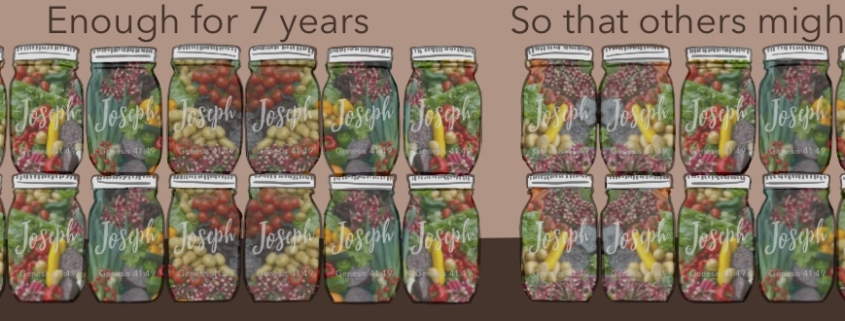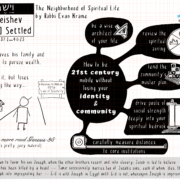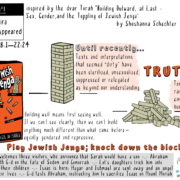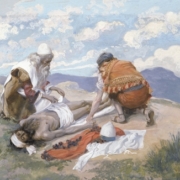Miketz: Food Justice

Part of an ongoing series that explores Torah through an ethic of social justice and building a world worthy of the Divine.
Joseph was thirty years old when he became Pharaoh’s right-hand man. He began his career in civil service by traveling throughout the land of Egypt, implementing his plan to store food for the seven years of famine that were to follow the seven years of plenty.
וַתַּ֣עַשׂ הָאָ֔רֶץ בְּשֶׁ֖בַע שְׁנֵ֣י הַשָּׂבָ֑ע לִקְמָצִֽים׃ וַיִּקְבֹּ֞ץ אֶת־כּל־אֹ֣כֶל שֶׁ֣בַע שָׁנִ֗ים אֲשֶׁ֤ר הָיוּ֙ בְּאֶ֣רֶץ מִצְרַ֔יִם וַיִּתֶּן־אֹ֖כֶל בֶּעָרִ֑ים אֹ֧כֶל שְׂדֵה־הָעִ֛יר אֲשֶׁ֥ר סְבִיבֹתֶ֖יהָ נָתַ֥ן בְּתוֹכָֽהּ׃ וַיִּצְבֹּ֨ר יוֹסֵ֥ף בָּ֛ר כְּח֥וֹל הַיָּ֖ם הַרְבֵּ֣ה מְאֹ֑ד עַ֛ד כִּי־חָדַ֥ל לִסְפֹּ֖ר כִּי־אֵ֥ין מִסְפָּֽר׃
And the land produced in the seven years of abundance by fistfuls. And he gathered all the food of the seven years, which were in the land of Egypt, and he put the food in cities; he put the food of the city’s fields that were around it inside of it. And Joseph piled up so much grain like the sand of the sea until he stopped counting, because it was without number. (Genesis 41:47-49)
The description of Joseph’s methodology in verse 48 inspires numerous commentaries. For example, the thirteenth century rabbi Chizkiah ben Manoach, author of Chizkuni, explains that Joseph “stored inside each city the kind of food that had grown in its vicinity, so it would be near at hand when the time came for drawing on these supplies.” Here Joseph is portrayed as pragmatic: each community will be equipped with its own food pantry during the lean years.
We can learn a lot from Joseph’s ancient system of food storage, practical lessons for our 21st century cities, where wealthy residents live surrounded by gourmet markets while those on “the other side of the tracks” live in food deserts, a mile or more from a store with no car or public transportation.
Rabbeinu Bahya, who also lived in the thirteenth century, offers another explanation for putting the food in each city: “Joseph’s procedure as reported here caused our sages (in Bereshit Rabbah 90:5) to state that when local food supplies are stored locally, such food supply will keep, as the earth of that neighborhood acts as a preservative for what it has produced.” It appears Joseph also possessed some knowledge of agriculture and food preservation techniques.
Joseph’s plan was so successful that when the famine became severe throughout the region, he was not only able to feed the Egyptian people; he also sold surplus food to those who traveled to Egypt from neighboring lands.
Examining Joseph in this light, I can see why the sages of the Talmud call him “Joseph the righteous.” He is a role model for food justice.
According to Nikki Henderson, “Food justice is the belief that healthy food is a human right, so everyone has an inherent right to access healthy, fresh food.” Henderson is the Executive Director of People’s Grocery, “whose mission is to improve the health and economy of West Oakland through the local food system.” The organization maintains a community garden and partnerships with a local hospital, grocery store, and food distribution service.
Food insecurity has existed in our communities for many years and has worsened considerably since the onset of the COVID-19 pandemic. Food pantries all over the United States are experiencing an increase in their clients’ needs for food, clothing and hygiene products. Reverend Dr. Lisa Heilig, Executive Director of Toco Hills Community Alliance here in Atlanta, Georgia reports a 25% increase in use of services from May through August 2022. They need both financial support and volunteers to meet increased demand during the winter months.
How can we engage in food justice? We can emulate our righteous ancestor Joseph, by supporting the work of contemporary food justice advocates to ensure our neighbors are well-nourished and to fulfill the vision of the prophet, “if you offer your food to the hungry and satisfy the needs of the afflicted…you shall be called the repairer of the breach, the restorer of streets to live in.” (Isaiah 58:10-12)


Author, artist, and teacher Rabbi Pamela Jay Gottfried is a member of the Bayit board.
Illustration by Steve Silbert, lead builder for Visual Torah and Bayit Games.









